Key Takeaways
- Many students who struggle with basic mathematics courses benefit from digital instructional technologies, including additional visual and supplemental materials on difficult concepts and skills.
- An intelligent tutor facilitates creation of supplemental materials and alerts both students and the instructor when performance on math assignments and quizzes falls below a predetermined threshold.
- The individualized additional support provided online preserves students' privacy while enabling them to work on improving their math skills and ultimate course success.
I choose to teach basic mathematics courses to students who struggle with math because of my interest in how people learn. Many of my students are turned off by math after many years of struggling with it, making it difficult to get them motivated. Some students are too distracted by their day-to-day work or family lives to focus on math. Still others are just not academically aggressive. For many of these students, my increasing use of digital instructional technologies has been a significant benefit, supporting their acquisition of math skills and encouraging their persistence in the course and ultimately in college completion.
Digital Media: A Visual Way of Presenting Math
Harcum College uses the WebStudy Learning learning management system. I began using the LMS to create a series of quizzes for my students, which they could take at times of their choosing, and also as a way to expose them to computer use. The LMS also allowed me to make instructional media available to my students online. Over the past few years, I have been developing slideshows and other visual media to address the many topics we cover in the basic math courses. (Figures 1–3 show sample slides covering specific math concepts in my classes.) It has been exciting for me to watch students respond to my increased use of visual materials in class and the supplemental materials I have developed for the courses.
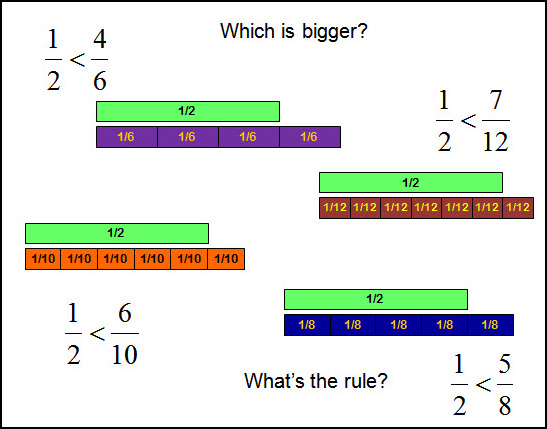
Figure 1. Fractions
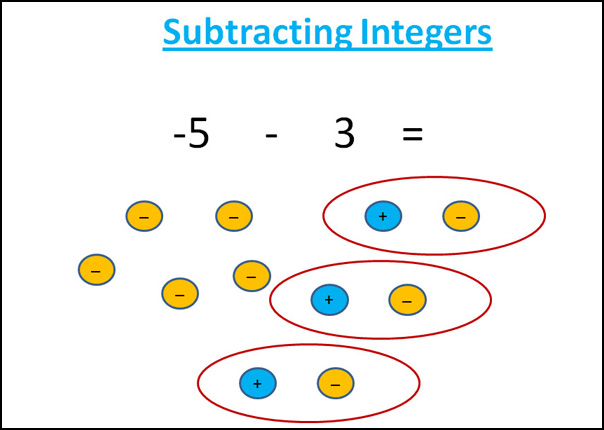
Figure 2. Subtracting Integers
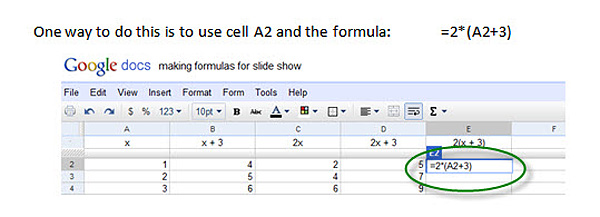
Figure 3. Creating Formulas
Currently, the intelligent tutoring technology feature in the LMS should make it easier for students to deal with material that is difficult for them by offering a focused and manageable way to get extra support. When someone doesn't do well on one of the online quizzes, the MyWebStudyTutor feature will identify the difficulty for the student (and me) and automatically make available additional materials tailored to a specific concept or skill through the LMS.
The way it works is, I set a threshold on an assignment, a quiz, or an exam. When a student performs below that threshold, the intelligent tutor in the LMS releases supplemental slideshows or materials needed to help explain the course content. Students don't have to ask for help in class or fear being singled out for a low quiz score. No one else has to know that they are getting supplemental materials. Figure 4 shows an example notification message.

Figure 4. Example of Notification to a Student
As I identify areas of difficulty for students, I develop visual material, usually in the form of a narrated slideshow that focuses on the specific concept or skill. While the Internet has thousands of videos offering math instruction, my students are not likely to search for such materials1 — nor are they likely to benefit from yet another person scribbling symbols at them while standing in front of another white/blackboard. As my students adjust to my method and style of presentation, they prefer to use materials that look and feel familiar to them from the course.
The materials I make available in the tutor mode include focused slideshows that students can move through at their own pace. I also provide additional practice exercises (with answers) focused as specifically as possible on the skill or concept that the student is struggling with. Figure 5, for example, shows a mixed practice with problems in adding and subtracting negatives. Finally, I offer students a short "catch-up" quiz that they complete independently and submit to me to improve their score.
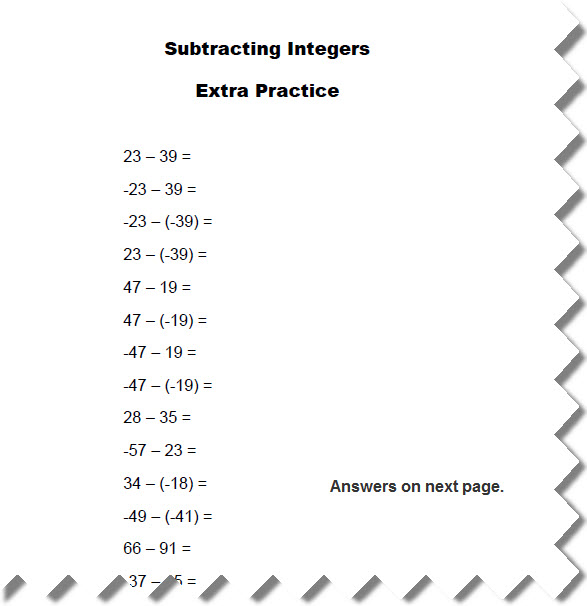
Figure 5. Mixed Practice
This format allows students to work on math issues on their own time. It also allows them to avoid any public exposure — either of weak mathematics skills or of motivation to succeed, depending on the student. And best of all, it facilitates their success in the course, encouraging their persistence in obtaining higher education and ultimately a college degree.
Common Pitfalls for Math-Challenged Students
I am currently using the MyWebStudyTutor application for two different courses: Fundamentals of Mathematics and Basic Algebra. The application requires me to specify objectives, and I usually address more than one objective within a single quiz. Figure 6 shows a list of several quizzes with their specified objectives.
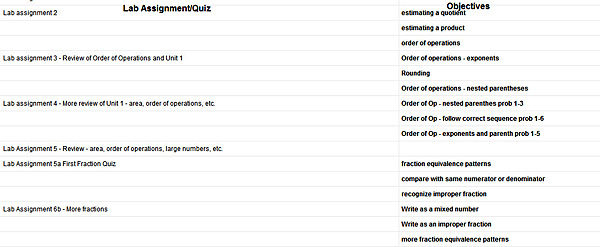
Figure 6. Quizzes and Objectives
When students are learning to multiply fractions, for instance, my quizzes mix various multiplication problems together. The tutor application allows me to differentiate between multiplying proper fractions and multiplying improper fractions. Or when working with simple linear equations, I can differentiate between equations that use only positive numbers and equations that involve negative numbers or subtracting a variable. Having identified problems in a specific quiz that had to do with one of these sub-skills, I can set a threshold for the tutor to release skill-specific materials if a student performed below a certain level.
Developing adequate materials for an entire course is a daunting task. Happily, several years of experience teaching this material has taught me the math areas most likely to be difficult for students. I typically begin by developing supplemental materials for those specific concepts or skills. The process is cumulative, and I hope that within a few more semesters, I will have a range of supplemental materials for virtually all of what we study. I have also done this long enough to know that no matter how extensive my materials, there is always another student who will show me additional areas I need to address or a new way to approach a topic.
I have also begun to use MyWebStudyTutor as a diagnostic instrument. Even before I develop additional instructional materials, I can set up the system to identify student success on any skill I specify as long as it is addressed by my quizzes (which I can also modify at will). Figure 7 shows an example screen based on quiz questions. This practice is helping me identify areas of difficulty that I might have previously overlooked or misunderstood. While I spend time trying to teach estimation and approximation, for example, the tutor scoring demonstrated that many of my students still struggled with the topic. In this case, better instruction and additional materials are clearly needed.
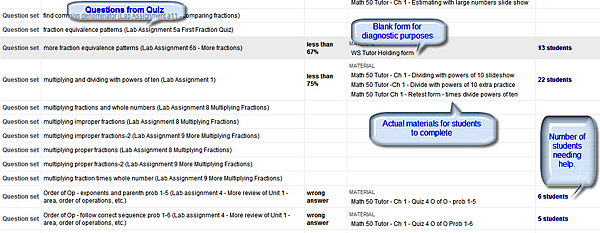
Figure 7. MyWebStudyTutor as a Diagnostic Tool of Student Skills
Using MyWebStudyTutor
In my trial of the MyWebStudyTutor technology, I made a few mistakes, but when I asked for help, I realized that the mistakes were easily corrected. I benefited from two sessions with a trainer, who walked me through the procedures. In general, the instructor needs to be able to determine when a student misunderstands the concepts, and then create a rule to release additional materials with MyWebStudyTutor.
My advice to other instructors beginning to work with an intelligent online tutor is to:
- First, be modest in your early expectations. No one is going to design his or her entire class with an intelligent online tutor the first time out of the gate. Pick one or two concepts or skills to target. Then you can stay focused on finding the most appropriate materials to help students with the most common pitfalls.
- Second, try to accept that something might go wrong at a technical level when you're using new technology, and it may not have anything to do with you. The power could go out, for example, so don't wait until the last minute to plan your use of the system and further development of materials.
- Third, give yourself plenty of time to get used to the steps to upload materials. It's kind of like learning to drive a car. After a time it becomes automatic, but when you're first learning how to drive, there are all of these steps that you have to think through. Practice until you get comfortable with it.
Motivated Students Benefit from Intelligent Tutoring
Another instructor who has used the intelligent tutor has said:
"This is the best gift you could give me in my last year of teaching before I retired. For 35 years I told students who failed the first exam to drop it and take it again next semester, and they never listened. Now I can help those who really want to overcome where they are stopped."
This semester, I'm just beginning to get reactions from students using the system. The most motivated or mature students seem to be the first ones to use the available materials productively. I expect that as I develop more materials, and use of the tutor becomes more widespread within the class and the college, it will fulfill its potential as a valuable part of providing instructional support to students. Increasing their ability to acquire basic skills and move forward in their educational program is a definite benefit for both the students and the college, which has a mission of improving the number of students who reach degree completion.
- This is due to students' limited experience and search skills. Moreover, when they use YouTube, they are looking for music or entertainment, not "math."
© Michael Wolf. The text of this article is licensed under the Attribution-NonCommercial-No Derivative Works 3.0.
